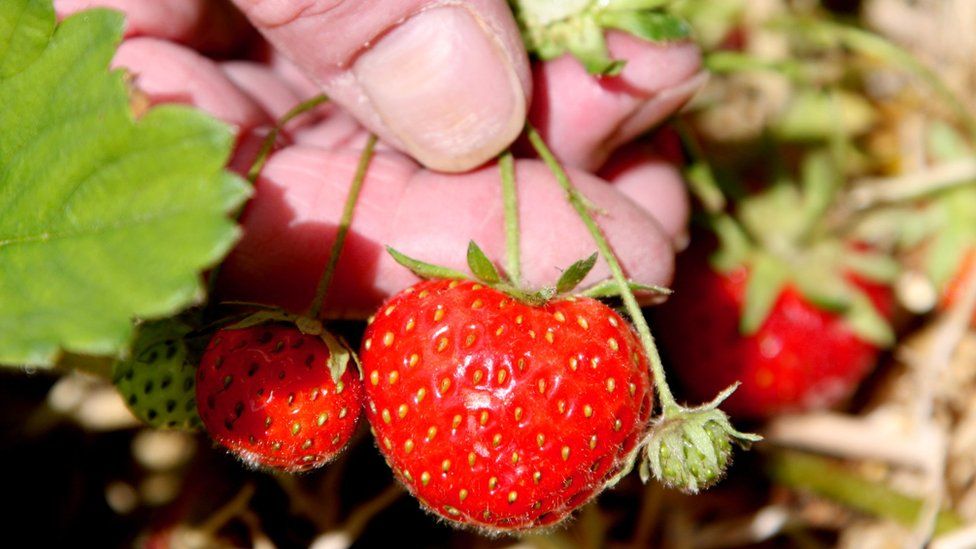Civic pride 'can help sustain urban biodiversity'
- Published

The establishment of community gardens in inner city areas can boost social and ecological sustainability, suggest researchers.
A study found those that produced food were the ones most likely to deliver "win-win" scenarios.
Urban green spaces managed by local people were more likely to be preserved for future generations, they added.
The scientists have created an "allotment of the future" as part of Manchester's City of Science festival.
"The production of food and the degree to which sites were cultivated for food was catalytic for the overall benefits from ecosystem services," explained Matthew Dennis from the University of Salford's Ecosystem and Environment Research Centre.
"It was a nice way of looking at it, that the more effort to cultivate an area for food, the more overall benefits are gained from the site."
Dr Dennis highlighted some of characteristics of successful "collectively managed spaces".
"We are talking about have some sort of leadership, such as a community champion or a gatekeeper," he told BBC News.
"Very often the sites are secure, they are established, and they have regular opening times. People then know that they can go there, be safe, and have a sense of ownership.
"There have been examples of greening or growing things in much more public spaces - inside parks or on road verges for example - but they tend not to do very well as there is not that sense of ownership or place, the community is not able to get a sense of pride from it.
"It is strange really because once you put a fence around something, give it a name and a shed, then it belongs to the community and it thrives. This is what I have found anecdotally rather than statistically."
Research has shown that green urban sites such as allotments, community garden, or cemeteries, can make a major contribution to sustaining urban biodiversity. They offer insect-friendly habitats, which improves pollination for plant species, and attract predators such as birds etc.
This biological diversity also makes the space more appealing for people, said Dr Dennis, and reinforces the value of the area to the wider community.
Growing appeal
Allotments have long been a part of the urban landscape, from wartime "dig for victory" campaigns to post-war austerity and rationing. The activity has seen a surge in recent years as people have looked to reconnect with their food. Many local authorities now have waiting list of people wanting to get their hands dirty.
Since the UK's first city farm opened its gates in 1972, the movement has been growing steadily with more than 120 city and school farms, and in excess of 1,000 community gardens. These are ones listed by the charitable Federation of City Farms and Community Gardens.
However, the emergence of urbanisation and a growing awareness of the merits of food and nutrition security has led to a new form of growth in the city.
Another researcher from the University of Salford, Michael Hardman, is looking at the rise of urban agriculture - large-scale urban commercial farms.
He said the development of urban agriculture was displaying the hallmarks of a movement that extended it beyond a "foodie fad".
"Only a few years ago, you had people involved in allotments and community gardens but a lot of the projects that are starting now are more than just a fad or just for recreation, there are serious business models behind some of these," he told BBC News.
"In Salford, they are building an urban farm in the middle of a huge regeneration development and that is going to have more of a commercial focus."
Dr Hardman cited a string of other examples of commercial urban farm ventures in North-West England, ranging from Liverpool to Stockport.
"It is almost becoming mainstream. We are seeing more and more local authorities, such as Brighton, buying into the idea and embedding it into the planning processes."
Global estimates show that we now live in an urban world, with the majority of people living in cities rather than in rural locations. By the middle of this century, 60% of all humans are projected to call towns and cities home.
This means that urban areas are going to have to play their part in terms of delivering food and nutrition security. However, Dr Hardman says there is no expectation that it will replace rural agriculture.
"One of the main challenges is finance," he observed. "While it is relatively easy to set up a community garden or allotment, the large-scale urban agriculture - the things that make a real difference, such as urban farms or things that embrace the more technical aspects, funding is very scarce.
"Our research has shown that a lot of the urban farming projects around the UK are relying on grants or they are working with charities, so they are always looking for the next application to put in a bid somewhere else.
"Others are just self-funded, so they are relying on volunteers all the time. It is not a rosy picture at all at the moment.
He suggested: "What we need is more businesses and more innovative people to get on board and push the practice forward as much as possible."
As part of the City of Science festival in Manchester, researchers have been inviting people to consider how the "allotment of the future" will look.
"We have got everything down there, from conventional growing all the way through to hydroponics, which are quite quirky systems that allows you to grow in smaller spaces," Dr Hardman explained, "as well as showing how it is possible to grow mushrooms in used coffee granules."
Follow Mark on Twitter.
- Published19 October 2013
- Published3 April 2014
- Published12 January 2014
- Published6 November 2013
- Published10 February 2012
- Published13 September 2011